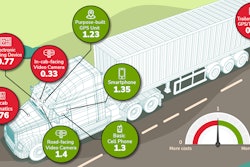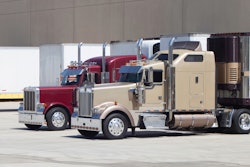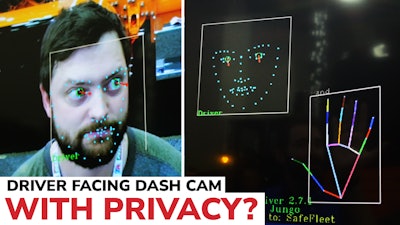
Bennett Heavy & Specialized-leased owner-operators Robert and Donna Benson, out of Carthage, Missouri, know first-hand how a dashcam can save your bacon in the event of an accident.
Bennett requires the team to have the camera in their truck, Donna said, but even before that, they used one, and it paid dividends. While Donna was driving, a Tesla driver sideswiped them and then told police Donna left her lane. The officer was going to ticket both drivers, Donna said, but after she noted she had video, the officer viewed it on the spot and only ticketed the auto driver.
“It saved us a bundle,” Donna said.
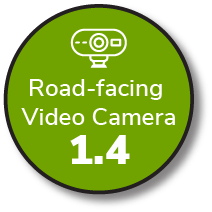 Road-facing cams posted the highest cost-benefit measure of all techs surveyed by Overdrive readers in our State of Surveillance survey. Measures greater than 1 equate to greater benefits than costs.
Road-facing cams posted the highest cost-benefit measure of all techs surveyed by Overdrive readers in our State of Surveillance survey. Measures greater than 1 equate to greater benefits than costs.

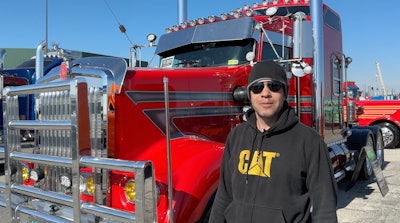 Owner-operator Rindelhardt hauls in this 2000 W900L.
Owner-operator Rindelhardt hauls in this 2000 W900L.
Both of those examples, however, are about camera technology that monitors and views the road ahead, an important distinction when it comes to questions of costs and benefits among Overdrive’s audience. Road-facing cameras scored the absolute highest cost-benefit ratio measure in Overdrive’s State of Surveillance survey -- their perceived value was highest versus perceived costs.
Can you guess which tech scored the lowest?
In-cab, driver-facing cams could well represent the most hated, outrage-inducing concept in all of trucking. Ask a trucker and it’s not hard to see why.
Owner-operator Rindelhardt put it succinctly: “It’s an invasion of privacy.”
Camera vendors place bets on new privacy options
Utah-based Ron Henrie, an owner-operator with 30 years of driving experience who now mostly pulls a reefer, is a pretty high-tech trucker. Like most owners, he uses his smartphone (browsing load boards, making calls), a GPS to keep him on route, the ELD mandated to run in his 2021 Freightliner, and yes a road-facing dashcam to keep a record of what goes down up ahead.
Echoing 38% of State of Surveillance survey respondents, the camera gives Henrie “peace of mind,” he said. “I’m not an aggressive driver. I’m pretty laid-back. I’m actually a slow driver as an owner-op. I have a clean record, never had an accident, not even a ticket” for a moving violation.
Why bother with the camera? Henrie cites “the idiots that are out there these days trying to brake check you. … It gives me peace of mind that I have proof. Everyone is so sue-happy these days.”
[Related: How the nuclear-verdicts threat rolls downhill to small fleets, owner-operators]
Surely if video evidence from a road-facing cam can provide so much value, wouldn’t another camera trained on you further fortify your position of strength?
“I will never do it,” Henrie said of installing a driver-facing cam. “I don’t care if insurance or the government mandates it, I will not do it.
“You let me put a camera in your bedroom so I can watch you whenever I want. When everyone who sits behind a desk, the government or a company or a broker, they let me put a camera in their bedroom and I can watch them, then I’ll put a camera in this truck.”
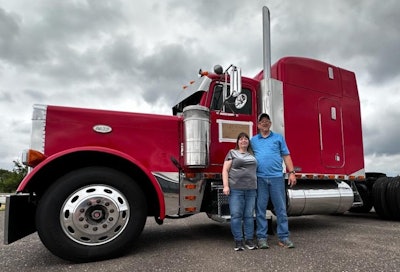 Owner-op Ron Henrie and his wife with his recently purchased new Peterbilt. He dropped the 2021 Freightliner for this one in June.Courtesy of Ron Henrie
Owner-op Ron Henrie and his wife with his recently purchased new Peterbilt. He dropped the 2021 Freightliner for this one in June.Courtesy of Ron Henrie
Henrie hits the nerve at the center of the issue. He said no other worker would stand for the level of surveillance and scrutiny asked of truck drivers by the driver-facing camera. “As far as I’m concerned, this is my home on the road,” said Henrie. The driver-facing camera, therefore, goes beyond workplace surveillance and straight into personal space.
At the Mid-America Trucking Show in Kentucky this March, representatives for MobileMule, a road- and driver-facing, AI-powered dashcam from the Rear View Safety company, expounded on the virtues of filming drivers at work.
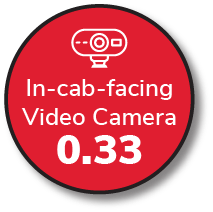 Driver-facing cams in Overdrive's survey were rated lowest by respondents. Measures less than 1 indicate greater perceived costs than benefits.
Driver-facing cams in Overdrive's survey were rated lowest by respondents. Measures less than 1 indicate greater perceived costs than benefits.
MobileMule’s system isn’t just a camera. Like others emerging in recent times, it uses AI to key into exactly what the driver is doing, and what makes them human. In a demo of the tech presented to Overdrive, the AI quickly recognized this author’s face and hands. Look away from the road for too long, and a voice chastises you to “look at the road.”
(Access a transcript for the video at the bottom of this post)
As explained by Rear View Safety’s Jon Hoefer in the video above, distraction and other events are mitigated with direct driver feedback, a relatively new feature of these kinds of systems. Events are also recorded and made available for back-office review -- this helps fleets “understand who needs coaching and who needs rewarding” among drivers in a fleet, said another company rep.
For owner-ops and small fleets who value their drivers’ independence, however, that’s just not translating. “Especially smaller fleets or unionized fleets, we’re not seeing them pick it up,” the rep said of the dual-facing cameras. He pinned it on “privacy and cost,” saying “a lot of drivers don’t love the idea of having their face forever enclosed on a video file on someone’s desktop that they don’t know,” and citing “a lot of pushback and privacy arguments” from drivers.
MobileMule, of course, has an answer to these concerns -- Artificial Intelligence. Not only does this camera only film a driver when they’re driving, skipping those private moments “at home” in the cab, it also can actively use AI to blur the drivers face and features, anonymizing those to anyone besides fleet leadership or parties in a lawsuit.
According to the rep, this “takes privacy completely out of it while maintaining the ability to critique their functional driving.”
But does Henrie buy that? What if Henrie’s insurance went down, what if his face would be blurred always, and his privacy would be perfectly protected, would he then equip his truck with a driver-facing camera?
“I still won’t use it. Never. I don’t care what they do to it, you’re taking my freedoms away,” he said.
On the cost front, it’s easy to understand why owner-ops like Henrie don’t bite. Samsara’s dual-facing dash cam, with similar features to MobileMule’s, retails around $2,160 for the hardware and three years of license on the software, according to Samsara's website. After that, it’s $60/month for the software.
At today’s average rates, though, that’s a bit less than a dry van load would pay to take a trailer from Houston to Tucson.
Asked to do some cost-benefit analysis, respondents to Overdrive’s State of Surveillance survey scored in-cab-facing video cameras 6 out of 10, or a moderate high cost in terms of dollars, data, privacy, time and hassle.
 Download full survey results via this link.
Download full survey results via this link.
Asked how beneficial this technology was to their operation, the in-cab-facing video camera scored a dismal 2 out of 10, the least-beneficial of any technology referenced in the survey. Independents scored it lat 1.9, with leased owner-ops rating benefits lowest at 1.8 on average, company drivers (the most likely group to have such a camera foisted upon them) 2.2.
Just 1% of owner-ops and 2% of leased and company drivers said the tech was in use in their operation. With 377 respondents, that 1% falls in the margin of error for the cost-benefit ranking derived. Precious few owner-ops who like in-cab cameras exist, and indeed Overdrive wasn’t able to connect with a single one. Driver-facing cameras appeal to fleets as a coaching tool with recording capability, and a real-time in-cab monitor that can beep at a driver who appears drowsy. Suppliers of such systems hope those latter features -- the ability to deliver direct feedback to the driver -- eventually appeal to operators as well.
 Download full survey results for a larger view via this link.
Download full survey results for a larger view via this link.
Motive, like Samsara among leading providers of electronic logging devices to independent owner-operators and small fleets, wouldn’t name a hard price for its own AI Dashcam dual unit, yet noted pricing is structured much like its ELD service. Owner-operators don’t purchase the hardware, just a subscription to the service.
Read next: In-cab and out, camera options expand amid push-pull of privacy concerns, regulatory attention
All the features in Trucking's State of Surveillance:
Podcast -- Truckers 'canaries' in the tech mine: Inside story around 'Data Driven' book on ELD mandate, rise of 'new workplace surveillance'
Video monitoring, in two parts:
**Can AI transform the prying eyes of in-cab cameras for the better?
**In-cab and out, camera options expand amid push-pull of privacy concern, regulatory attention
ELDs/smartphones and location tracking -- Broker intrusions on the rise with ubiquitous location tracking capability
Truck and trailer telematics -- Telematics beyond ELD systems: Promise, redundancy and real expense/uptime benefits
Data mining -- The third parties following you around freight networks: Brokers looking more like carriers with 'data driven' decision-making
Smartphones/GPS -- Counterpoint to some truckers' tech reticence: 'If you use a smartphone, you embrace it'
Roadside inspections -- 'Nothing to hide, nothing to fear,' right? Get ready for Level 8, automated inspections
Podcast -- FMCSA offering 'kinder, gentler' approach to safety scoring? Not if automated inspections go live
VIDEO TRANSCRIPT:
Jon Hoefer: This is our MobileMule AI platform. This would be a dashcam. But then also there is a camera that is AI-based, faced inward towards the driver. And actually, if you want to step up here a little bit.
Alex Lockie: Let's get started. All right.
Speaker 3: Face acquired.
Jon Hoefer: So you can see it says, "Face acquired now." So what this has done is it's basically recognizing who that driver is while you're there, and also it's being able to see what you're doing. So you can see it's tracking eye movements. If you would close one eye, it'll show that it's actually closing an eye and showing what's there. But if you would turn away for a little while, or if you would not pay attention, you see a bar go up the side of the screen.
Speaker 3: Look at the road.
Alex Lockie: It just said to me, "Look at the road."
Jon Hoefer: Yes it did.
Once you've fully gotten that bar all the way to the top, it logs as a distracted event. So a lot of what's out there on the market will alert the fleet manager, but it won't audibly help the driver. And so this is one thing that we're trying to give some more tools for the drivers as well. So we actually have a privacy mode here that'll black out.
You can see that it's actually still tracking all of your movements without actually capturing the video that is associated with that behavior.
But there's also another mode here that kind of works within the same, is a blurred out mode. So it's kind of like a happy medium, but you can still see a little bit more in this mode. But having that blacked out mode with those privacy concerns while still being able to capture all of the things that we're trying to, is a very unique sort of feature.
And this is the dashboard we actually have. So this is actually what you can see. And since it's AI, what's interesting is rather than drivers logging in or tracking distractions based on the vehicle usage, it's actually coaching scores based on the driver usage. So it can actually recognize a driver and tie, even if you're swapping vehicles, it can actually continue to show your scores and improvements as a driver, not just as a specific like vehicle two or vehicle three. This is all cloud-based storage. So anytime there's an incident, that footage is actually recorded and it's actually saved for easy download.
So this incident here, you can see the individual was talking on their cell phone. Again for wifi connection, but I could actually pull up a short clip here about 10 seconds before the incident started, up to about 10 seconds afterwards. And then you can always download that footage if you need it as well.



